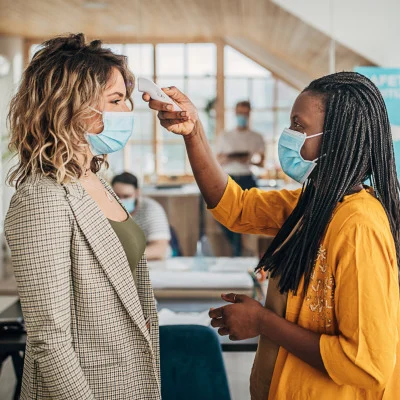Essential workers, especially those in healthcare, have a greater risk of COVID-19 due to the nature of their work. Aside from healthcare workers (HWCs), however, not much is known as to which other occupational groups are most at risk for infection.
You might also like: How Exposure to SARS-CoV-2 Varies Across Hospital Settings
A new U.K. research (Mutambudzi et al. 2020) examined the risk of severe COVID-19 by (1) broad essential occupational groups, (2) detailed essential occupational groups, and (3) Standard Occupational Classification (SOC) 2000 major groups. Researchers took into account baseline demographic, socioeconomic, work-related, health, and lifestyle-related risk factors to assess risk ratios (RRs) for testing positive in hospital or death due to COVID-19.
Notable findings of the study include:
- Relative to non-essential workers, healthcare workers had a more than seven-fold higher risk of severe COVID-19, while those working in social care and transport occupations had a two-fold higher risk.
- No strong associations observed for the other essential worker groups (police and protective service, food service or education workers).
- Non-white essential workers had the highest risk of severe COVID-19 infection.
"The comparisons of severe COVID-19 risk across health and social care occupational groups highlighted how these higher risks seem to be particularly linked to the jobs, rather than reflecting broader socioeconomic circumstances," study authors point out.
For this study, baseline UK Biobank data (2006–10) for England were linked to COVID-19 test results from Public Health England (16 March to 26 July 2020). Included participants were employed or self-employed at baseline, alive and aged <65 years in 2020. White (British, Irish and other) participants accounted for 92.2% of the study sample, and South Asian and Black participants accounted for 2.6% and 2.7%, respectively.
Employed participants were classified into five broad groups (non-essential workers, healthcare workers, social and education workers, police and protective service, and ‘other’ essential workers). To allow for more comparability, the researchers also assessed the associations between risk of severe COVID-19 and the SOC 2000 major occupation groups (managers and senior officials, professional occupations, associate professional and technical occupations, administrative and secretarial occupations, skilled trades occupations, personal service occupations, sales and customer service occupations, process, plant and machine operatives, elementary occupations).
The researchers found that, compared with managers and senior officials, associate professional and technical occupations had the highest risk. Other occupations with higher risk are personal service and process, plant and machine operatives. The other occupational groups (professional, administrative and secretarial, skilled trades, sales and customer service, and elementary occupations) did not have an elevated risk.
Based on their findings, the researchers say policies and workplace interventions – e.g. provision of protective equipment, health information drive and training – are imperative to reduce exposure and curb spread of infectious diseases in the workplace.
"Our findings reinforce the need for adequate health and safety arrangements and provision of PPE [personal protective equipment] for essential workers, especially in the health and social care sectors. The health and wellbeing of essential workers is critical to limiting the spread and managing the burden of global pandemics," the authors conclude.
Further study is needed to assess risk differences among other working groups, such as younger workers, and monitor how COVID-19 progression and its long-term effects may have an impact on different occupational groups, the authors add.
Image credit: South_agency
via iStock


![Tuberculosis Diagnostics: The Promise of [18F]FDT PET Imaging Tuberculosis Diagnostics: The Promise of [18F]FDT PET Imaging](https://res.cloudinary.com/healthmanagement-org/image/upload/c_thumb,f_auto,fl_lossy,h_184,q_90,w_500/v1721132076/cw/00127782_cw_image_wi_88cc5f34b1423cec414436d2748b40ce.webp)







